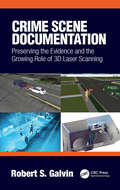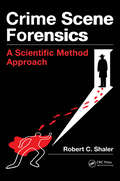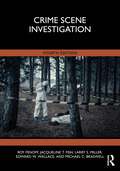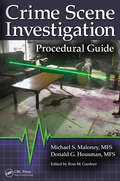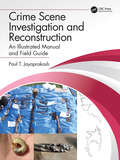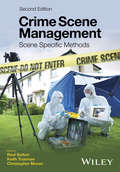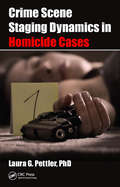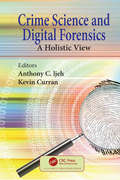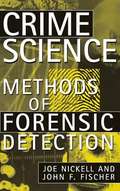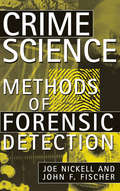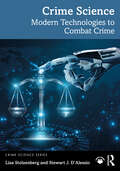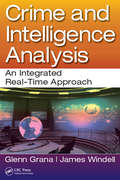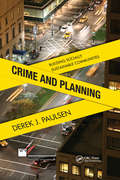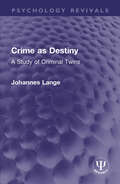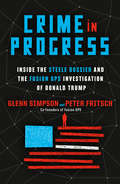- Table View
- List View
Crime Scene Documentation: Preserving the Evidence and the Growing Role of 3D Laser Scanning
by Robert S GalvinWhen a criminal act or vehicle crash occurs, most often a local law enforcement agency responds and is responsible for both investigating the scene and for documenting it. It is critical that scene evidence is collected and recorded efficiently, as the scene can quickly change. The sooner evidence can be collected, reviewed, and analyzed, the better an understanding investigators will have as to how and why the incident occurred. Crime Scene Documentation: Preserving the evidence and the growing role of 3D laser scanning demonstrates at length the value of laser scanning through the use of numerous case studies of investigators who have utilized various 3D technologies and laser scanning to document scenes. Thorough and accurate scene documentation is an essential function at a science and proves particularly valuable in courtroom presentations to help jurors understand a crime or accident’s likely chain of events. The more advanced a scene documentation method is, the better it can be utilized to capture details that will lead to optimal scene diagramming. Currently, 3D laser scanning is the most advanced method of scene documentation available, capturing detailed and realistic digital scans—capturing scenes in their entirety—and yielding a permanent representation of the scene for study and analysis at any time, even years after a crime scene has vanished. The book explains current technology, the latest advances, and how to best utilize the technology. Case examples come from various applications, from tools to programs, can help crash scene investigators understand how scanning can improve scene documentation, provide better and more evidence details, and build more credible diagrams that possibly may be used in court presentations to help support a case. Key Features: Describes 3Dscene recording methods in use and how well they work Outlines the variables and inherent challenges associated with documenting crime and crash scenes Illustrates the positive, and dramatic, impact of having a well-documented scene, particularly in the courtroom Explores how 3D laser scanning has vastly changed the way and extent to which crime and crash scenes can be captured accurately and completely, and subsequently analyzed Explains how laser scanning is highly flexible and presents strategies to integrate it into other crime scene incident recording techniques and technologies Crime Scene Documentation details the many benefits of 3D laser scanning technology relative to its reliability and accuracy as well as the multiple case scenarios in which it can be used. The book serves as an invaluable resource to crime scene technicians, investigators, and reconstructionists on the best ways to document a crime or crash scene.
Crime Scene Forensics: A Scientific Method Approach
by Robert C ShalerBridging the gap between practical crime scene investigation and scientific theory, Crime Scene Forensics: A Scientific Method Approach maintains that crime scene investigations are intensely intellectual exercises that marry scientific and investigative processes. Success in this field requires experience, creative thinking, logic, and the correct
Crime Scene Investigation
by Larry S. Miller Michael C. Braswell Jacqueline T. Fish Edward W. Wallace Roy FenoffCrime Scene Investigation offers an innovative approach to learning about crime scene investigation, taking the reader from the first response on the crime scene to documenting crime scene evidence and preparing evidence for courtroom presentation. It includes topics not normally covered in other texts, such as forensic anthropology and pathology, entomology, arson and explosives, and the electronic crime scene. Numerous photographs and illustrations complement text material, and a chapter-by-chapter fictional narrative also provides the reader with a qualitative dimension of the crime scene experience.
Crime Scene Investigation Procedural Guide
by Ross M. Gardner Michael S. Maloney Donald HousmanThose tasked with investigating crime scenes come from a variety of backgrounds and varying levels of experience. Crime Scene Investigation Procedural Guide gives the novice investigator the procedures for almost any crime scene imaginable while providing the seasoned pro a ready reference for crimes occurring even under the most unusual of circums
Crime Scene Investigation and Reconstruction: An Illustrated Manual and Field Guide
by Paul T. JayaprakashCrime Scene Investigation and Reconstruction: An Illustrated Manual and Field Guide provides methodologies to help investigators to think broadly when seeking out evidence at a scene and, likewise, utilize all the information from a case—especially the observable physical evidence, besides what are collectable, in reconstructing events. In the introductory chapters the author highlights the importance of crime scene reconstruction when answering the question “How something could have happened?” From there, he goes on to explain the principles of exchange, identification, individualization and reconstruction. Here, the “observe-hypothesize” model, proposed in this field-guide, is presented: outlining how every source of information ranging from laboratory reports, opinions from medical doctors, statements of witnesses, and confessions of suspects should be reconcilable with the evidence-based reconstruction made in the crime scene. In this, the author contends that qualified crime scene generalists are the ideal professionals to frame scientific hypothesis and to make reconstructions. Practical recommendations, based on best-practice general crime scene procedures are provided while the second half of the book illustrate and outline how to deal with various types of major crime scenes, including fire deaths, exhuming buried human remains, sexual assaults, death by electrocution, explosion, drowning, poisoning, hanging, and more. Since a picture is a worth thousand words, over 400 collective photographs and sketches are included throughout the book to illustrate the observational methods that are described. In addition, the field-guide provides several easy-to-follow flow-charts to serve as checklists to aid scene investigation in major types of crime scene. In this, Crime Scene Investigation and Reconstruction: An Illustrated Manual and Field Guide will help investigators readily recognize similar manifestations in crime scenes and to apply and use such techniques appropriately in their own work.
Crime Scene Investigation: Step By Step From The Crime Scene To The Courtroom
by Larry S. Miller Michael C. Braswell Jacqueline T. Fish Edward W. WallaceCrime Scene Investigation offers an innovative approach to learning about crime scene investigation, taking the reader from the first response on the crime scene to documenting crime scene evidence and preparing evidence for courtroom presentation. It includes topics not normally covered in other texts, such as forensic anthropology and pathology, arson and explosives, and the electronic crime scene. Numerous photographs and illustrations complement text material, and a chapter-by-chapter fictional narrative also provides the reader with a qualitative dimension of the crime scene experience.
Crime Scene Investigations
by Daniel J. BaumWhen police are called in to investigate a crime, what powers and limitations apply to them? What are their rights to question strangers, search without warrants, or detain individuals who might become suspects? Crime Scene Investigations breaks down the Supreme Court's decisions on questions like these into clear and practical terms. Police need to be vigilant, since the line between a lawful search and an improper one can be dangerously thin, and officers can be held accountable for any wrongdoing, intentional or not. The controversy surrounding such techniques as "stop-and-frisk" sweeps and compulsory DNA testing underscores the importance of understanding the legal dimensions of police powers. Because interactions between law enforcement officers and civilians are often charged with complexities, Crime Scene Investigations provides a level-headed guide, indispensable for those on either side of an investigation.
Crime Scene Management within Forensic Science: Forensic Techniques for Criminal Investigations
by Neeta Raj Sharma Jaskaran SinghThis book, the second volume of Crime Scene Management in Forensic Sciences, reviews the role and impact of forensic evidence in criminal investigations. It also addresses the importance of post mortem examination in criminal cases. The book investigates the use of insects and arthropods to estimate post mortem intervals during forensic investigations. Further, it discusses the physiological effects of xenobiotics at the time of death, based on their concentration and distribution in the body at autopsy. Importantly, it also discusses digital forensic investigation, which can be used for the analysis of digital evidence produced at a court of law. Lastly, it defines the structure and legal framework of these forensic evidences for the effective administration of the criminal justice system. It is an excellent source of information for forensics scientists and legal professionals.
Crime Scene Management within Forensic science
by Neeta Raj Sharma Jaskaran SinghThis book provides deep insight into the significance of various forensic techniques underlying the methodical approaches in criminal investigations. The book comprises numerous case studies, examples, and reference materials. It emphasizes on the better practices for criminal investigations including contemporary examinations. The book also describes various methods for investigation of crime scene and evidence collection including biological evidences to the resources of law enforcement agencies. This book encompasses the procedure for crime scene-documentation through photography, video, and diagrams and highlights the best practices of packaging the biological evidences at a crime scene. Further, it summarizes the role of forensic autopsy to the criminal investigation system. As such, the book is helpful for forensic scientists, medical practitioners, educators and law enforcement personnel.
Crime Scene Management: Scene Specific Methods
by Christopher Moran Keith Trueman Raul SuttonSecond edition of an established text on common procedures for the identification and processing of evidence at scenes of crime Includes chapters on quality assurance and credibility of practices and processes issues surrounding major and complex crime Forensic handling of mass fatalities Crime scene reconstruction and impact on evidence recovery processes
Crime Scene Management: Scene Specific Methods
by Christopher Moran Keith Trueman Raul SuttonSecond edition of an established text on common procedures for the identification and processing of evidence at scenes of crime Includes chapters on quality assurance and credibility of practices and processes issues surrounding major and complex crime Forensic handling of mass fatalities Crime scene reconstruction and impact on evidence recovery processes
Crime Scene Photography (Second Edition)
by Edward M. RobinsonCrime Scene Photography, Second Edition covers the general principals and concepts of photography, while also delving into the more practical elements and advanced concepts of forensic photography. Edward Robinson assists the reader in understanding and applying essential concepts in order to create images that are able to withstand challenges in court. The first part of the book deals with the basic theory and science of photography required to take superior photographs, and covers topics such as composition, exposure, focus, depth of field, and flash techniques. The second part of the text deals specifically with the challenges of photographing a crime scene, including instructions on how to document bodies and wounds, traffic accident photography, underwater photography and aerial photography. In the latter portions of the text, the author turns to digital theory and its advantages and disadvantages. * Over 600 full color photographs, also electronically available on the companion website * Two new chapters on 'The History of Forensic Photography,' and 'Digital Image Processing of Evidentiary Photography' * Includes an Instructor website with lecture slides, practical exercises, a test bank and image collection * An essential reference for crime scene photography, including topics such as Composition, the Inverse Square Law, Court Cases affecting photography, Digital Image Processing, and Photogrammetry * Required reading by the Crime Scene Certification Board of the International Association for Identification (IAI) for all levels of certification
Crime Scene Processing and Investigation Workbook, Second Edition
by Christine R. Ramirez Casie L. Parish-FisherCrime Scene Processing and Investigation Workbook, Second Edition is the only workbook which directly supports and cross-references methodology and terminology presented in Ross Gardner and Donna Krouskup’s perennial best-seller Practical Crime Scene Processing and Investigations, Third Edition. The workbook serves as supporting material offering hands-on activities to supplement theories and methodologies within the text as well as updated activities to support the new material presented in the Third Edition. As the number of forensic academic programs within the United States continue to grow—and the textbook continues to be a go-to standard in the field—the workbook remains an invaluable reference for academics, forensic training providers, and law enforcement training programs. The detailed Instructor’s Manual (IM) lends itself not only to experts who have utilized these procedures before but also to the novice and student who may be introduced to these topics in a classroom setting for the first time. The workbook conducts over 30 activities with detailed instructions, concept overviews, and reflective post-lab questions. Crime Scene Processing and Investigation Workbook, Second Edition, continues to stand as the best workbook on the market, addressing foundational principles in a hands-on manner while directly correlating to the concepts addressed in the Gardner and Krouskup textbook.
Crime Scene Processing and Laboratory Workbook
by Patrick Jones Ralph E. WilliamsThe most important part of a CSI‘s (crime scene investigator) job is accurate documentation of properly collected evidence. Documentation tells the story of the crime and can ultimately prove a suspect guilty. Through an array of specific exercises and actual document templates used in practice, Crime Scene Processing and Laboratory Workbook teache
Crime Scene Staging Dynamics in Homicide Cases
by Laura Gail PettlerIndividuals who perpetrate murder sometimes pose or reposition victims, weapons, and evidence to make it look like events happened in a different way than what actually transpired. Until now, there has been scarce literature published on crime scene staging.Crime Scene Staging Dynamics in Homicide Cases is the first book to look at this practice, p
Crime Scene: Inside the World of the Real CSIs
by Connie FletcherMost people who work as actual crime scene investigators will tell you two things: Television doesn't always show the truth...and science never lies. But how do DNA experts, trace analysts, medical examiners, forensic pathologists, and cold case detectives work together to produce evidence and solve a case—beyond the shadow of a doubt? In this fascinating, true-life account, America's leading crime experts share their personal, unforgettable stories. From powder burn to fiber analysis, blood spatter to skeletal remains, New York Times bestselling author Connie Fletcher takes you into a world of crime-solving that's even grittier, more bizarre, and more shocking than any TV show. It's a thrilling ride into the dead center of a crime scene.
Crime Science and Digital Forensics: A Holistic View
by Anthony C. IjehThis volume is a collation of articles on counter forensics practices and digital investigative methods from the perspective of crime science. The book also shares alternative dialogue on information security techniques used to protect data from unauthorised access and manipulation. Scandals such as those at OPCW and Gatwick Airport have reinforced the importance of crime science and the need to take proactive measures rather than a wait and see approach currently used by many organisations. This book proposes a new approach in dealing with cybercrime and unsociable behavior involving remote technologies using a combination of evidence-based disciplines in order to enhance cybersecurity and authorised controls. It starts by providing a rationale for combining selected disciplines to enhance cybersecurity by discussing relevant theories and highlighting the features that strengthen privacy when mixed. The essence of a holistic model is brought about by the challenge facing digital forensic professionals within environments where tested investigative practices are unable to provide satisfactory evidence and security. This book will be of interest to students, digital forensic and cyber security practitioners and policy makers. It marks a new route in the study of combined disciplines to tackle cybercrime using digital investigations and crime science.
Crime Science: Methods of Crime Detection
by Joe Nickell John F. FischThis method is empirical (from the Latin empiricus, "experienced"), meaning that knowledge is gained from direct observation.
Crime Science: Methods of Forensic Detection
by Joe Nickell John F. FischerThis comprehensive guide to forensic investigation &“delivers the goods for the educated layperson . . . readers will be hard-pressed to put it down&” (USA Today). Forensic experts Joe Nickell and John Fischer introduce readers to the work of firearms experts, document examiners, fingerprint technicians, medical examiners, and forensic anthropologists. These topics are explained in clear terms without technical jargon. Nickell and Fisher describe fingerprint classification and autopsies, explain how fibers link victims to their killers, and examine the science underlying DNA profiling and toxicological analysis. From weapons analysis to handwriting samples to shoe and tire impressions, Crime Science outlines the indispensable tools and techniques that investigators use to make sense of a crime scene. Each chapter closes with a study of an infamous case to demonstrate how the principles of forensic science work in practice. Case studies including the O.J. Simpson trial, the Lindbergh kidnapping, the death of Marilyn Monroe, the World Trade Center bombing, the assassination of the Romanovs, and the Atlanta child murders.
Crime Science: Modern Technologies to Combat Crime (Crime Science Series)
by Lisa Stolzenberg Stewart J. D'AlessioThis book comprehensively examines the rapidly changing tactics and technologies used to combat crime. The authors delve into the intricacies of how scientific methodologies and technological advancements are employed to investigate and prevent various forms of crime, exploring topics such as forensic science, cybercrime, data analytics, crime mapping, predictive policing, and other technological and scientific advancements that aid law enforcement and criminologists in their work. It explores the interplay between criminology, technology, and science and arms readers with knowledge about cutting-edge techniques and technologies utilized in the fight against crime. Through engaging narratives, case studies, and expert insights, this book sheds light on the intricate web of scientific disciplines that play a pivotal role in uncovering and solving crimes. The technologies covered represent a complex web of tools available to law enforcement and other criminal justice agencies. However, it is important to recognize that integrating these technologies requires careful consideration of legal, ethical, and social issues, including privacy rights and potential biases in predictive algorithms. As technology continues to evolve, so will the tools available for crime prevention, detection, and prosecution. It is an ongoing process of balance and adjustment as society seeks to ensure safety and justice while preserving individual rights and freedoms. Appropriate as a textbook for crime science, criminal investigation, and crime prevention courses in criminology and criminal justice programs, Crime Science: Modern Technologies to Combat Crime is also useful for professionals and others intrigued by the world of crime and investigation. This book is a groundbreaking exploration into the important role science plays in comprehending, preventing, and solving crimes in the modern era.
Crime and Intelligence Analysis: An Integrated Real-Time Approach
by James Windell Glenn GranaCrime and Intelligence Analysis: An Integrated Real-Time Approach covers everything crime analysts and tactical analysts need to know to be successful. Providing an overview of the criminal justice system as well as the more fundamental areas of crime analysis, the book will enable students and law enforcement personnel to better understand criminal behavior, learn the basics of conducting temporal analysis of crime patterns, use spatial analysis to better understand crime, apply research methods to crime analysis, and more successfully evaluate data and information to help predict criminal offending and solve criminal cases. Criminal justice and police academy students will learn how to be skilled and credible crime analysts who play a critical role in the daily operations of law enforcement.
Crime and Planning: Building Socially Sustainable Communities
by Ph.D., Derek PaulsenThe form and layout of a built environment has a significant influence on crime by creating opportunities for it and, in turn, shaping community crime patterns. Effective urban planners and designers will consider crime when making planning and design decisions. A co-publication with the American Planning Association, Crime and Planning:
Crime and the Life Course
by Michael BensonIn recent years, the lifecourse perspective has become a popular theoretical orientation toward crime. Yet despite its growing importance in the field of criminology, most textbooks give it only cursory treatment. Crime and the Lifecourse: An Introduction by Michael L. Benson provides a comprehensive overview of contemporary research and theory on the life-course approach to crime. The book emphasizes a conceptual understanding of this approach. A special feature is the integration of qualitative and quantitative research on criminal life histories. This book: provides an overview of the life course approach and describes the major concepts and issues in lifecourse theory as it applies to criminology reviews evidence on biological and genetic influences on crime reviews research on the role of the family in crime and juvenile delinquency provides a detailed discussion of the criminological lifecourse theories of Moffitt, Hagan, Sampson and Laub, and others discusses the connections between youthful crime and adult outcomes in education, occupation, and marriage presents an application of the lifecourse approach to white-collar crime discusses how macro sociological and historical developments have influenced the shape of the lifecourse in American society as it relates to patterns in crime.
Crime as Destiny: A Study of Criminal Twins (Psychology Revivals)
by Johannes LangeFirst published in 1931, Crime as Destiny throws a beam of light across the darkness which enshrouds the study of the deeper causes of crime and the eternal debate between nature versus nurture. The author’s investigations led him to conclusions of the first importance to the sociologist and the psychologist. But the subject is wilder than it seems and by its direct bearing on the question of determinism will arouse the interest of the theologian and the student of philosophy as well. For the student of history, this research work will help trace the beginning of the logic of eugenics that will eventually take its nightmarish form under Hitler.
Crime in Progress: Inside the Steele Dossier and the Fusion GPS Investigation of Donald Trump
by Peter Fritsch Glenn SimpsonBefore Ukraine, before impeachment: This is the never-before-told inside story of the high-stakes, four-year-long investigation into Donald Trump’s Russia ties—culminating in the Steele dossier, and sparking the Mueller report—from the founders of political opposition research company Fusion GPS. <P><P>“Crime in Progress untangles one of the great mysteries of the Trump era—the full story of the Steele dossier—and provides a fascinating insight into the investigatory mind at work.”—Jeffrey ToobinFusion GPS was founded in 2010 by Glenn Simpson and Peter Fritsch, two former reporters at The Wall Street Journal who decided to abandon the struggling news business and use their reporting skills to conduct open-source investigations for businesses and law firms—and opposition research for political candidates. In the fall of 2015, they were hired to look into the finances of Donald Trump. <P><P>What began as a march through a mind-boggling trove of lawsuits, bankruptcies, and sketchy overseas projects soon took a darker turn: The deeper Fusion dug, the more it began to notice names that Simpson and Fritsch had come across during their days covering Russian corruption—and the clearer it became that the focus of Fusion&’s research going forward would be Trump’s entanglements with Russia.To help them make sense of what they were seeing, Simpson and Fritsch engaged the services of a former British intelligence agent and Russia expert named Christopher Steele. <P><P>He would produce a series of memos—which collectively became known as the Steele dossier—that raised deeply alarming questions about the nature of Trump&’s ties to a hostile foreign power. Those memos made their way to U.S. intelligence agencies, and then to President Barack Obama and President-elect Trump. <P><P>On January 10, 2017, the Steele dossier broke into public view, and the Trump-Russia story reached escape velocity. At the time, Fusion GPS was just a ten-person consulting firm tucked away above a Starbucks near Dupont Circle, but it would soon be thrust into the center of the biggest news story on the planet—a story that would lead to accusations of witch hunts, a relentless campaign of persecution by congressional Republicans, bizarre conspiracy theories, lawsuits by Russian oligarchs, and the Mueller report.In Crime in Progress, Simpson and Fritsch tell their story for the first time—a tale of the high-stakes pursuit of one of the biggest, most important stories of our time—no matter the costs. <P><P><b> A New York Times Bestseller </b>
